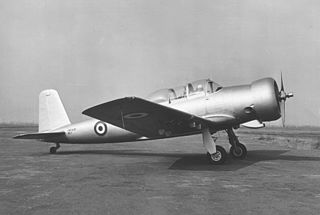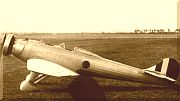
The Auster J/1U Workmaster is a late 1950s British single-engined single-seat high-wing agricultural monoplane built by Auster Aircraft Limited at Rearsby, Leicestershire. Of traditional high-wing layout, it carries 90 gallons of spray fluid in a tank beside the pilot, an extra seat being provided for a passenger. The Lycoming 0-360-A engine of 180 h.p. driving a McCauley v.p. propeller giving it ample power; and slotted ailerons and balanced tail controls providing good handling. Oversize tyres were fitted. Take-off run at 2,550 lb gross weight and cruising speed at 65 per cent power are respectively 180 yd and 88 miles per hour (142 km/h). Britten-Norman spray gear was provided by Crop Culture, and this company ordered nine Workmasters.

The CANT 26 was an Italian two-seat biplane trainer built by CANT.

The Fleetwings Model 33 was a 1940s American primary trainer prototype airplane built by Fleetwings.

The Harlow PJC-2 was a 1930s American four-seat cabin monoplane, designed by Max Harlow.

The Farman F.50 was a French twin-engined night bomber designed and built by Farman as a replacement for the single-engined Voisin pusher biplanes in service with the French Air Force.
The Farman F.51 was a 1920s French maritime reconnaissance flying boat designed and built by Farman. The F.51 was an unequal-span four-bay biplane flying boat with a crew of four. It was powered by two Lorraine 8bd engines mounted in tractor configuration. A pusher engined version was designated the Farman F.50 . Tested by the French Navy but it failed to win any orders, Farman did briefly consider a civil version but the project was abandoned.

The Farman F.70 was a 1920s French passenger and mail transport aircraft designed and built by the Farman Aviation Works. It was a smaller counterpart to the company's popular F.60 Goliath. The F.70 was an unequal-span two-bay biplane with a wooden fuselage and was powered by a Renault 12Fe piston engine. The pilot was seated in an open cockpit behind the nose-mounted engine. Behind the open cockpit was a cabin for four passengers or freight.

The Fiat G.49 was an Italian two-seat basic trainer designed by Giuseppe Gabrielli and built by Fiat.

The Wassmer WA-80 Piranha is a French two-seat low-wing cabin monoplane trainer designed and built by Société Wassmer. Based on the same construction as the company's WA-50 four-seater, the WA-80 was a scaled down version. The prototype, registered F-WVKR, first flew in November 1975 powered by a 100 hp Rolls-Royce Continental O-200 engine. Wassmer appointed a receiver and suspended production in 1977 after 25 had been built.

The Farman F.160 A.2 was a 1920s French sesquiplane designed as a military reconnaissance and observation aircraft. Only one was built.
The Farman B.2 was a 1920s French biplane designed as a light day bomber. Only one was built.
The Farman F.150 was a 1920s French twin-engined biplane designed by Farman as a day bomber.
The Farman F.130 was a 1920s French biplane designed by Farman as a long-range day bomber.

The Farman BN.4, a.k.a. Super Goliath, was a very large 1920s French biplane designed by Farman as a long-range night bomber.

The Farman F.110 was a French two-seat artillery observation biplane designed and built by the Farman Aviation Works.

The Fiat G.5 was an Italian two-seat aerobatic tourer or trainer designed and built by Fiat Aviazione in small numbers.
The Farman F.270 was a prototype French bomber/torpedo-bomber designed and built by the Farman Aviation Works for the French Air Force.

The Farman F.370 was a French single-seat racing monoplane designed and built by the Farman Aviation Works for air racing.
The I.P.D BF-1 Beija-Flôr was a two-seat light helicopter designed by Henrich Focke.

The Caudron C.161 was a lightweight French two-seat biplane designed by Caudron for sport or flight training use. A conventional biplane with a square fuselage powered by a 65 hp (48 kW) Salmson radial engine. It had two cockpits in tandem with dual controls in both, when not used as a trainer the controls could be removed from the rear cockpit. A variant, the C.168, with a more powerful 70 hp (52 kW) Anzani radial engine was also available.